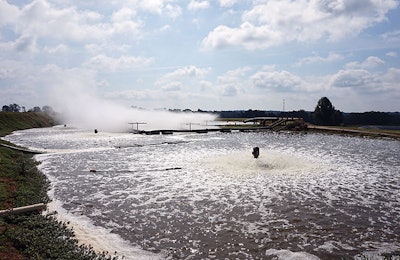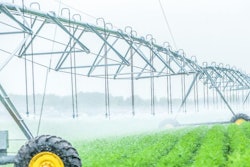
American Proteins Inc.’s operation in Cumming, Georgia, illustrates the mindset of leading poultry companies focused on providing value to customers through improved performance and community relations. In doing so, the American Proteins Cumming Division received an Honorable Mention in the 2017 U.S. Poultry & Egg Association’s Clean Water Awards’ full treatment category.
The Cumming Division operates one of the largest rendering plants in the world in the most affluent county in the state. It recovers almost 30 million pounds of inedible poultry offal, feathers and other related materials received six days a week from 13 locations. The facility produces poultry, feather, secondary protein nutrients and blood meal as well as pet-grade products. Production occasionally runs through Sunday morning leaving less than 24 hours for a full sanitation and major maintenance. But, down time is not an option as aligning operations with processor schedules is critical to the entire poultry industry.
A daily average of 550,000 gallons of poultry wastewater is reclaimed from cooking, pressing and drying finished products. The division’s wastewater treatment system balances the high strength process effluent with a significant volume of product condensate water while employing odor control measures. A land application system (LAS) provides the final treatment and groundwater recharge. As a result, the facility coexists in an area seeing tremendous growth due to its proximity to Lake Lanier, a major recreational destination.
Screening and dissolved air flotation (DAF) with chemical addition begin the process water treatment with a goal of capturing any residual protein, oil and grease. The condensate waters are then blended in advance of anaerobic digestion, the first biological treatment step. Several advanced treatment ponds centered on a pair of sequencing batch reactor basins (SBRs) follow.
“If we operated a conventional activated sludge system with continuous flow into anoxic and aeration basins, we could slip stream our condensate flow to take advantage of its high organic carbon and low organically-bound nitrogen characteristics to achieve better denitrification,” Jonathan Greene, American Proteins Cumming Division’s complex manager, said.
As configured, the facility has a short stage time in the SBRs during the fill cycle with low dissolved oxygen levels. Yet, it does have a variety of other ponds that provide flexibility.
“One of the interesting features we have is the kidney pond, named for its shape,” Greene said. “It operates as a facultative pond and receives the SBRs’ discharge, helping us target and manage our effluent nitrate-nitrite loadings before the land application system.”
“We get tremendous performance out of our covered anaerobic lagoon so we could send the process effluent after dissolved air flotation treatment without chemistry,” Roger Smith, vice president for engineering services at American Proteins Cumming Division, said.
In 2016, about 67 million cubic feet of biogas was captured with about 75 percent of that volume usable for blending with natural gas. However, Smith and Greene said the goal is to maximize raw material recovery for products so DAF with chemistry is used. Achieving an optimum biogas production serving as an alternative energy source is a treatment priority, not a production priority. Currently, the overall natural gas used is reduced by 10 percent with biogas.
Leroy Woody, American Protein Cumming Division’s division environmental manager, leads the team charged with applying its understanding of the system’s complexities and flexibility for balancing and managing the daily wastewater treatment operations (see Table 1). Woods said it uses a supervisory control and data acquisition, or SCADA, system that is accessible remotely, “but we stay on top of the overall facility by keeping our eyes on things.” That includes monitoring one stormwater outfall even though the majority of stormwater is captured with the first 30 minutes treated before diversion to the ponds.
Woods said agronomic loadings to the land application system’s 184 acres address effluent nitrogen loadings. Required testing of the picturesque spray fields, which are surrounded by dedicated wildlife management areas, indicates the LAS soil’s capacity for phosphorus capture and monitored surface and groundwater quality remain acceptable.
In a cooling pond the 550,000 gallons of daily treated effluent is blended with a little over 19 million gallons per day in water removed from the incoming raw material coming and cooled before reuse. As a result, a significant portion of the treated effluent is used as makeup for the cooling pond, which supplies water to the non-contact cooling and condensing processes within the plant. Advanced technologies not traditionally associated with poultry processing – or even some other rendering facilities – are used to apply waste heat recovery with product lines to enhance efficiency as well as water reuse. The end result is an improved process thermal efficiency of about 30 percent to achieve similar overall product throughput.
The facility operates an aggressive odor abatement strategy to treat room air and unit process vapors. Here, process vapors are sent to wet scrubbers using chlorine dioxide, condensed and then evenly distributed across a biofilter designed to absorb any residual compounds into natural materials and use bacterial growth to eliminate odors. The biofilter is monitored and media changed every five years.
Moving forward, the Cumming Division will use a regenerative thermal oxidizer (RTO) to treat the most odoriferous feather process vapors while still upgrading the biofilter for its other air streams. These multimillion-dollar investments are not mandated but instead part of the Cumming Division’s desire to provide value to all of its customers and neighbors. Besides its facility investments, American Proteins is a significant benefactor for numerous local charitable organizations and others across the nation.
The Cumming Division consistently works to exceed its treatment permit requirements while keeping a keen eye towards conserving resources, alternative energy sources and protecting the environment. This commitment makes it a 2017 Clean Water Awards full treatment category Honorable Mention.

















